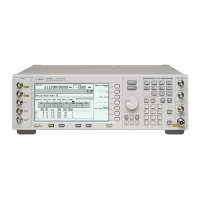524 Chapter 16
W-CDMA Uplink Digital Modulation for Receiver Test
Setting Up Compressed Mode for a Single TGPS Transmission
8. Set the duration of the first transmission gap pattern, which is expressed as a number of frames.
a. Move the cursor to highlight the TGPL1 field.
b. Press
6 > Enter.
9. Set the duration of the second transmission gap pattern, which is expressed as a number of frames.
a. Move the cursor to highlight the TGPL2 field.
b. Press
4 > Enter.
10. Set the compressed frame power relative to the non-compressed (normal) frames.
a. Move the cursor to highlight the PwrOffs field.
b. Press
6 > dB.
This enables you to compensate for reduced spreading gain. The higher power level makes the
compressed frames easier to view.
11. Enable the compressed frames.
Press the
TGPS Inactive Active softkey until Active is highlighted.
12. Press the
Apply Channel Setup softkey.
When the Apply Needed annunciator appears, press the
Apply Channel Setup softkey. The new settings
are not applied to the signal until this softkey is pressed.
Pressing this key disables the compressed mode trigger. Therefore whenever this key is pressed while
transmitting in compressed mode, the following step will have to be repeated.
13. Press the
Compressed Mode Start Trigger softkey.
The Comp trg annunciator appears and the ESG is now transmitting compressed frames.
The ESG does not transmit compressed frames until an external start trigger is received or the
Compressed
Mode Start Trigger
softkey is pressed. Compressed frame transmission is terminated when an external stop
trigger is received, the
Compressed Mode Stop Trigger softkey is pressed, or a parameter is changed and the
Apply Channel Setup softkey is pressed. You can also stop the transmitted compressed mode frames after a set
number of transmissions by changing the TGPRC field from Infinity to the desired number of repetitions.
Figure 16-52 shows what the ESG display looks like when this procedure is completed.

